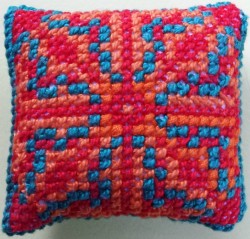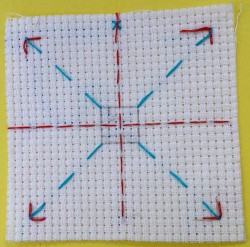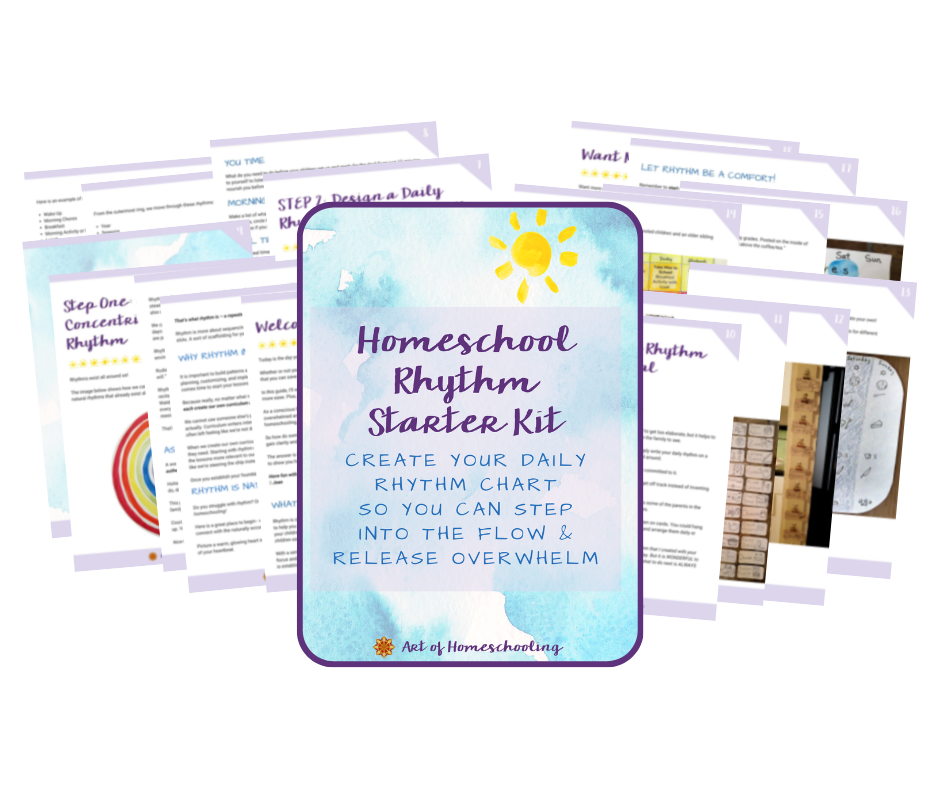This is a guest post by Alisha Trammell, who is the mother of 4, a handwork teacher, and has been a Waldorf-inspired homeschooler for over 10 years.  She has a profound appreciation of the Waldorf curriculum and how it speaks to the development of the child. She also understands the beauty and challenges of teaching from home. Alisha is currently in her third year of the Applied Arts program at Sunbridge Institute and she teaches handwork at Urban Oak School in Cleveland Heights. Alisha also leads the handwork workshops at the annual Taproot Teacher Training.
She has a profound appreciation of the Waldorf curriculum and how it speaks to the development of the child. She also understands the beauty and challenges of teaching from home. Alisha is currently in her third year of the Applied Arts program at Sunbridge Institute and she teaches handwork at Urban Oak School in Cleveland Heights. Alisha also leads the handwork workshops at the annual Taproot Teacher Training.
Here in this post, Alisha has some great projects for you! Including a 4th grade cross-stitch pin cushion, as well as projects that younger siblings can be doing at the same time, such as a placemat or name plate. Be sure to see the verse for cross-stitch, too!
As far back as I can remember, my mother was always making something. Little nighties for me, my first day of school outfits. She quilted and cross-stitched and, since she had an appreciation of history and women’s work, she did many things by hand.
It was a given that I would fall asleep to the whir of her sewing machine. She was always introducing me to crafts and projects…rug hooking, tin punching, folding paper into stars. I didn’t really realize the significance of all this until much later; my mother was exposing me to historical and cultural crafts. Only in my 20s, when I learned to knit, did I really start to appreciate what she had brought to me growing up. My maternal great-grandmother was a seamstress by trade and my gran was a sewer, too. So somehow, I feel a connection to them all by continuing to do handwork.
For these three hand sewing projects described here, I give age suggestions for the projects, but also know that beginners of any age can start with the first project and progress from there. And you are the best judge of your child’s abilities. Just remember to give plenty of time – handwork can take longer than you think!
The three projects are:
- Stitched Placemat (or Candlemat)
- Gingham Name Plate
- Cross-Stitched Pin Cushion or Sachet

Stitched Placemat or Candlemat
This project could be done with a child anywhere from Kindergarten to Grade 2 or up.
Supplies:
- Burlap (try asking for a coffee bean bag from a local coffee roaster)
- “Blunt” yarn needle (has a wide eye)
- Chunky or bulky yarn
Instructions:
- Cut the burlap to the desired size – depending on whether you want a placemat or a smaller candlemat.
- Fray the edges by removing edge threads.
- Starting in a corner, 4-5 threads in, begin a running stitch. (I did every 10 stitches with the outside color of blue in the picture); go all the way around the fabric.
- Add a second color and go every 5 stitches all the way around. (Yellow in this one.)
- You could even have a child draw around and then stitch the outlines for a glass, plate and silverware if you want to take this a step further. Great for learning to set the table!
This is a great project for second, third or fourth graders.
Supplies:
- Gingham fabric
- Embroidery needle and floss (divide and use 2-3 strands at once)
Instructions:
- Place “x”s in squares so to form a word or picture.
- Right-handers, stitch right to left. Left-handers stitch left to right.
- Be consistent so that the “x”s overlap in the same way on each square.
Cross-Stitch Pincushion or Sachet
This project is a typical 4th grade Waldorf handwork project.
Supplies:
- 6-count Aida cloth (available from Paper Scissors Stone or A Child’s Dream) – large enough to cut 31×31 squares for each pincushion.
- Large-eyed tapestry needle with blunt end
- Thread: #3 pearl cotton in 3 colors; choose dark, medium and light
Preparing the Design Space:
- Cut a piece of 6-count Aida cloth to 31×31 squares.
- Mark off a 28×28 square area.
- Using red thread or light pencil, indicate corners and center (vertical & horizontal).
- Divide again on the diagonal; now you will have 8 equal triangles – this is where you will “journey” (leave center empty). You may want to identify the “top” with a star.
Stitching Instructions:
- Stitch entire border first in darkest color. (Design moves in from outside border.)
- Your colors are going on a “Journey” within each section or triangle. Start at the border and travel (not in a straight line) into the center. (Leave the center square unfilled for now.) There are “Journey Rules” within each triangle.
For First Color Journey, you must:
- touch both side borders at least once,
- have no more than 4 stitches in a row,
- end at border.
- Second Color Journey:
- starts near (not in) center square,
- travels out toward border,
- crosses first journey color only once.
- Third Color fills in empty spaces.
Finishing Instructions:
- Finish center square in second color.
- When stitching is complete, choose a fabric for the bottom. Cut to same size as cross-stitch.
- Put right sides of cross-stitch and fabric together and pin. (Wrong sides facing out.)
- Sew along sides using your cross-stitched top as a guide (reinforce corners), leaving a gap for stuffing.
- Turn right side out and stuff with wool.
- Sew gap closed.
Fourth grade projects generally include embroidery, cross-stitch and hand sewing. Children this age are experiencing a new wakefulness and a separation from their surroundings which gives them the ability to observe their work objectively. The handwork that students in earlier grades experience has a more dreamy approach. Fourth grade projects include work with symmetry, awakening an appreciation for form, and leading to repeated experiences of crossing the midline.
The many steps within each project require the student to persevere to complete the project. And then each student’s completed project is the result of his or her own effort and brings satisfaction and enhanced self-esteem.
Here is a quote from my handwork training materials:
The object in question should be made to fit into its surroundings so that it becomes part of them, and its purpose should be expressed in its outer form – in both its function and its relationship to the rest of the world. In fact, the artistic should arise from the practical activities of life, from that which gives meaning to the object itself.
Verse for Cross-Stitch
(designed to be spoken facing east)
With my left hand I reach to the Star of the North
And I open my palm and I call its power forth.
And I grasp it and clasp it for all I am worth
And I bow and I bind with the power of the Earth.
With my right hand I reach to the Milky Way bright,
And I gather the power of its heavenly light.
And I feel as it courses through hand, heart and foot,
And I bow to the Earth, there the power to put.
Now I stand straight and tall, the human I be,
With my hand and my gaze reaching eternity.
Into darkness behind me I reach and I hold,
Gaining strength from the past and my ancestors bold.
To the north and the south like a cross now I reach,
And I open my mind while their wisdom they teach.
Now the power of the Earth I will bring to my heart,
As I treasure these gifts, now my work I may start.
You can read more about the importance of the lively arts and how to weave them into your lessons here: The Seven Lively Arts.






Hi Alisha, thank you so much for the detail on the cross stitch 4th grade pin cushion. I am a complete cross stich novice, so I have some more questions:
Could you show with crosses on paper the progression of your first triangle? Are you describing the design which you have a photo of, or are the instructions more general?
You have shown exactly how to for the stitch when working left to right, but when you are doing a complicated design, presumably your next cross could be anywhere: up, down, diagonal, even to the right, Voe even skipping a few holes? .. does it matter what the back looks like or do you just go where you want to?
Thanks very much ,
CAROL
Thanks for the questions, Carol. I’ll have Alisha answer when she gets back from her training tomorrow. And we can post a picture of the first triangle. In answer to your question about whether she is describing the design in the photo, or something more general, the answer is that the instructions are specifically for the pin cushion design in the photo.
Was there ever a reply / answer posted about Carols question?
Jenny
Thank you, Barbara! So helpful. I love the “neatness counts” pun!?
Thank you for this post! I will be using the grade four pin cushion pattern this year. Do you have any suggestions for olders? I am considering using a more complex pattern with my grade seven son.
Great question, Brooke. Alisha is on her way home from her Handwork training right now. So, she’ll answer in more detail this week. But I wanted to let you know that one possibility is to have your older son do the same pattern just on smaller cross-stitch fabric. So get Aida cloth that’s 11-count or 14-count (the higher the number, the smaller the stitches will be). The count is actually the number of stitches in one inch. Like I said, more to come from Alisha!
Hi, my first question on the 4th grade pincushion is…once I have purchased the aida cloth and thread skeins from paper scissors stone (which I have purchased and received in mail)…how many threads do I separate out of the 6 strand embroidery floss? Do I use all 6 strands or pull some smaller amount out? I’ll just ask that first but I also don’t understand the first/second/third color journey instructions/rules above..at all!
Most of the time, it’s best to use 2 strands at a time. So yes, you separate the 6 strands into 2.
Thank you for your quick response! I have been reading up on cross stitch and I realized that what comes from paper scissors stone is pearl cotton, which I now see is actually something different than embroidery floss! I didn’t realize that at first. My instinct tells me that this just is used whole, as it doesn’t separate out like embroidery floss. On the next topic, if there is anything that could be done to explain the “first and second color journeys” I would definitely appreciate it. I can make neither heads nor tails of the instructions! For example, looking at the picture, I can’t tell if orange or red is the first color, among other things. Thanks again!